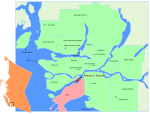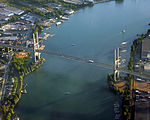Queensborough, New Westminster
Neighbourhoods in New WestminsterPopulated places on the Fraser River

Queensborough is a neighbourhood in the city of New Westminster, British Columbia, Canada. It is on the eastern tip of Lulu Island on the Fraser River.At the north end of Queensborough is a new development called Port Royal. To the south is Thompson's Landing, to the west is the industrial area of Tree Island, and to the east is the Fraser River. Access to Annacis Island, an industrial park area and site of one of the GVRD's sewage plants, is via a bridge towards the east end of Queensborough, though the island itself is not part of the City of New Westminster.
Excerpt from the Wikipedia article Queensborough, New Westminster (License: CC BY-SA 3.0, Authors, Images).Queensborough, New Westminster
Derwent Way, Delta
Geographical coordinates (GPS) Address Phone number Website Nearby Places Show on map
Geographical coordinates (GPS)
| Latitude | Longitude |
|---|---|
| N 49.183333333333 ° | E -122.93333333333 ° |
Address
Annacis Lockup
Derwent Way 555
V3M 6S9 Delta
British Columbia, Canada
Open on Google Maps





